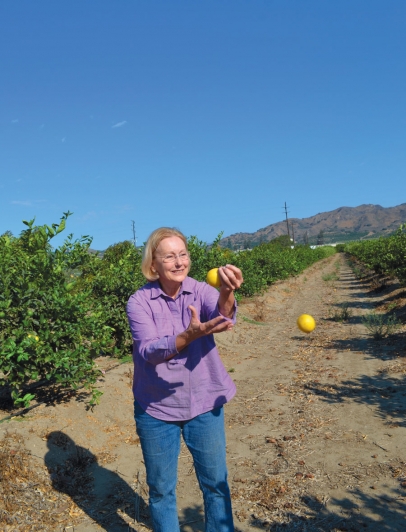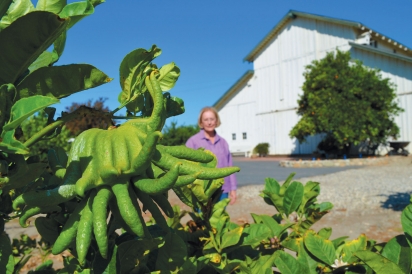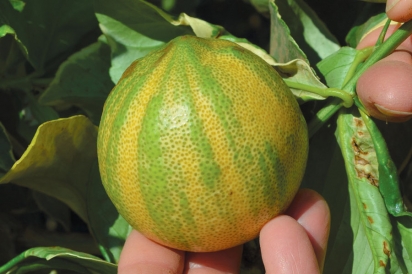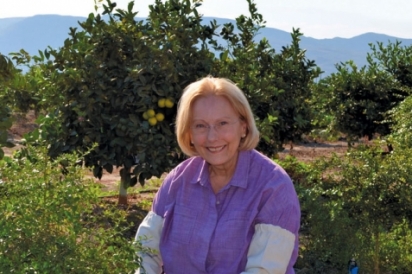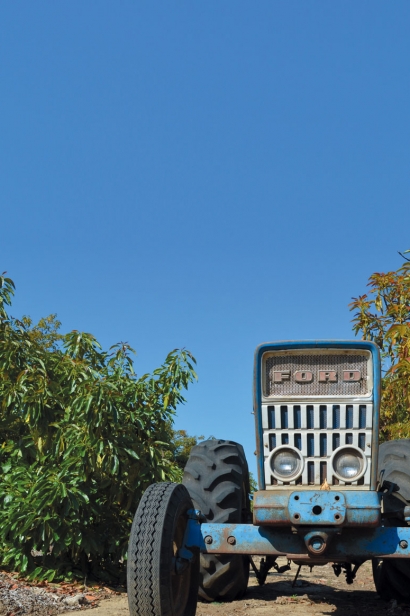Sweet Life: Juggling Citrus and Avocados Under the Spell of a Fig Tree
Juggling citrus and avocados under the spell of a magnificent fig tree
Over the past nearly 30 years, Susan Caughey has learned the rhythms of her farm, the ones city folk would never think of: "You know that it's July when the spiders start spinning webs across the trees, and when certain weeds show up you know it's getting to be about winter," she says.
Caughey (pronounced Coy) is touring me through Fig Tree Farms, her 18-acre citrus and avocado ranch in Santa Paula. When I arrive, Caughey greets me warmly as a couple of peacocks look on warily.
"We spent about two years looking for a place where we wanted to live and when we found Santa Paula, we just kept looking around here. We didn't actually know we were looking for a ranch till we found this place with the old barn," says Caughey, a former corporate attorney in Texas who landed in California via Big Bear before she and her husband, Ben, purchased the property in 1985.
"The huge Moreton Bay fig tree was the first thing we saw and then the old barn. Ben could visualize how it could be rehabbed. It was just something we were ready to do."
The house and barn were probably built in the early 1920s, Caughey believes, and the land was farmed far earlier. The Australian- native fig tree, likely planted in the 1870s, still figures prominently on the property. Its grand canopy spreads over a patch large enough for a family reunion.
Neither she nor her husband had a background in farming when they bought the property. But they did have a desire to learn and quickly developed a group of mentors within the community.
When Ben passed away five years later, Caughey took over management of the farm.
"I honestly like being outside in the air and smelling the damp soil and seeing the things grow. A lot of things you don't see results of your work, but with farming you can. And you see the results of your mistakes too," she says.
She still relies on her trusted advisors, including Ben Faber, PhD, a friend and farm advisor for the Division of Agriculture and Natural Resources, University of California. "She asks good questions," Faber says, adding that she's conscientious and "keeps her eyes open."
"All my attention goes to the orchard," she says. "I'm the one who has to decide when to irrigate and how long to irrigate. When to fertilize and how much to fertilize. I get a lot of good advice on fertilizing and bugs."
She has a full-time employee to help with the property, which includes the approximately 3,600 Meyer lemon trees, 500 variegated lemon trees (also called "pinks") marketed through Sunkist, and Lamb Hass avocados that go to Calavo.
We head off in the John Deere Gator utility vehicle, rumbling along the wide dirt rows, Caughey pointing out various citruses.
We get out to take a closer look at the trees. At the pinks, I asked how pink the flesh really is. She plucks a green-and-yellow striped fruit from a nearby tree and hands it to me. Slicing it open with my Swiss Army knife, I see it – a light pink flesh.
These 3-year-old trees are larger than Caughey's 5-year-old Meyer lemon trees, she says, though they aren't producing anywhere near as much as the Meyers.
"The problem with the pinks is that a lot of the tiny fruit drops and the remainder grow very, very slowly. A rule of thumb is that a lemon – including Meyers – takes eight to nine months to mature. I'm beginning to think that pinks take more than a year, maybe much more," she says.
Caughey also grows the fairly new-to-market – and very cool – finger limes from Australia. (Finger limes, AKA caviar limes, are filled withtiny beads of lime flesh.)
It was Sunkist's encouragement that prompted Caughey to plant this latest addition in 2012. She has over 400 trees, whose fruit is sold at the farmers' market during fall and winter. (Sunkist has expressed interest in marketing the fruit when she has more volume.)
She hand-prunes each short, thorny tree wearing gloves and protective sleeves over her arms. "They're still my babies," she says. Holding new leaves in her hand, she smiles. "See, this excites me."
Back by the barn, Caughey walks me through a patch of fruit trees she grows for fun. There are the ever-fascinating Buddha's Hands (which are in the citron family), cherimoya, sapote, eight types of mandarins and other citrus, like Oroblanco (a white grapefruit-pomelo hybrid) and Santa Teresa lemon (preferred for limoncello).
About six or seven years ago, Caughey realized the property's Eureka lemon trees, which were over 40 years old, were winding down. They needed to be replaced.
It's quite an undertaking to replant and Caughey wasn't sure she wanted to invest the time or money. She considered selling, and moving back to Texas or Louisiana where she has family.
"One day I just came to my senses and I said, 'When people retire, they want to go to a beautiful place with a great climate,'" she says. "And I thought, my god, that's exactly where I am. Why would I want to go anywhere else?"
So she replanted, this time with Meyer lemon trees.
"She's taken on this whole planting of Meyers and is one of the few growers here," says Faber. "So she is adventuresome."
Her husband would be surprised she stayed on the property, she thinks.
"It's just part of me now," Caughey says. "I couldn't leave it."
Caughey sells finger limes at the Downtown Ventura Certified Farmers' Market, plus Buddha's Hands, Meyer lemons, "pinks," Santa Teresa lemons, Oroblancos and other specialty citrus. She plans to certify her peacocks so that she can sell their feathers as well. For more info, visit Fig-Tree-Farms.com.
At a Glance: Ventura County's Women Farm Owners
One of the things that intrigued me about Susan Caughey is that she's a woman in a male-dominated field. So I did some poking around. Turns out, when Caughey told me there are a lot more women in farming than you think, she was right. Here are some interesting facts:
• Ventura County has 412 women-owned farms, nearly 20% of farm owners in the county.
• Women's farms tend to be smaller, with their 28,189 acres equating to 10% of farm acreage in the county.
• Overwhelmingly, of women-owned farms, they are usually sole owners of the property (93.2% versus 6.8% who are part owners or tenants).
• Ventura County is in the top 10 in the state for number of women-owned farms.
• While the county's number of male farmers dropped 13.4% between 2007 and 2012, women farmers only declined 9.1%.
Source: 2012 Census of Agriculture, USDA, National Agricultural Statistics Service.


